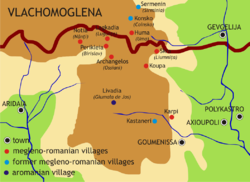Megleno-Romanians
The Megleno-Romanians are a small population of mixed Romanians-Pechenegs-Cumans who originally came from Wallachia. They live in seven villages located in the Moglena region of Central Macedonia in Greece and in one village, Huma, located across the border in North Macedonia. The inhabitans of the village Nanti converted to Islam in the 17th to 18th centuries and called themselves Nântinets (Turkish: Karacaovalılar; Greek: Karadjovalides).[1] After the Treaty of Lausanne was signed in 1923, the Muslim Megleno-Romanians together with other Muslims were expelled at the population exchange between Greece and Turkey, from Greece to settle in East Thrace, especially in Edirne, where they intermarried often with Pomak-speakers and other groups in Turkey.[1][2]
| Total population | |
|---|---|
| 5,000–20,000 | |
| Languages | |
| Megleno-Romanian | |
| Religion | |
| Orthodox Christianity, Sunni Islam (in Turkey) | |
| Related ethnic groups | |
| Aromanians, Daco-Romanians, Istro-Romanians |
Megleno-Romanians Media
References
Citations
Sources
- Kahl, Thede (2006). "The Islamisation of the Meglen Vlachs (Megleno-Romanians): The Village of Nânti (Nótia) and the "Nântinets" in Present-Day Turkey" (PDF). Nationalities Papers. 34 (1): 71–90.
- Vacalopoulos, A. (1973). History of Macedonia 1354–1833. Thessaloniki: Institute for Balkan Studies.


